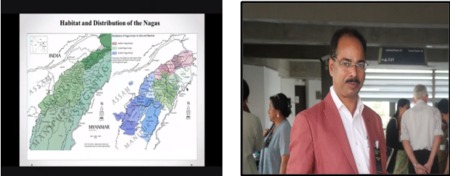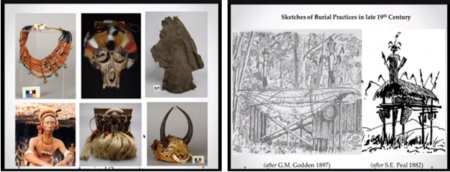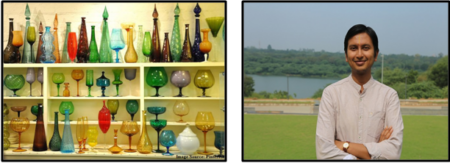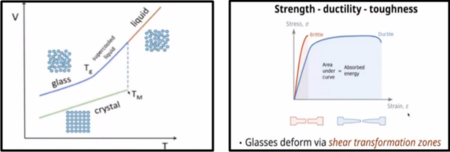
Hello friends! I hope you all are washing your hands with soap and water for 20 seconds at regular intervals, practicing social (physical) distancing, following the nation-wide lockdown to combat COVID-19, and staying safe.
I am back with the second installment of the Virtual Seminar Series, which is an online program initiated by IIT Gandhinagar. The aim is to engage students as well as the general public so that they can learn about a wide diversity of topics from the comfort of their homes, in an interesting yet informative manner. (For part I of this series, please visit here.) So, sit back with some food, relax and enjoy reading the mysteries of history, the wows of science, and the brilliance of research and technology!
So, let’s start with the lecture delivered by Alok Kumar Kanungo, faculty in Humanities and Social Science. It was a glimpse into the interesting lives of the Nagas! Focused on their tradition and culture, it attempted to provide an understanding of some aspects of the Naga lifestyle in which the richness is of the cultural world, and not the materialistic world!
Prof Kanungo explained how the world did not know most of the important information about the Nagas for many years. Why? Because the Inner Line Permit system was introduced in 1873. Furthermore, repeated burning of their villages and large-scale collections of their cultural objects before their land was closed for the outsiders in 1947, created a void in exploring the rich history of Nagas. But, scholars and researchers from different universities are working to understand the Nagas better (since the last two decades) and there is definitely some progress.
Perhaps, one of the best possible ways to know more about the culturally and traditionally rich lives of the Nagas is to analyze those aspects that are the last to change viz., their ornaments, and grave-customs. The Naga ornaments not just fulfilled the decorative purposes, but also categorized them as commoners or heroes. Indicators of strict tradition and probably the only commodities acquired from far-off places, these pieces were markers of long-distance trade and contact. Ornaments are a part of their identity, and hence, are a perfect means to address some crucial issues regarding the origin as well as migration patterns of Nagas. Detailed understanding of their dresses and ornaments are helpful in differentiating one group from the other.
Progressing to talk about their grave practices, Prof Kanungo expressed that platform burial is identical in most parts of the northern Naga hills. The grave goods like ornaments are hanged near the graves. In contrast, other villages bury their dead, while some Nagas decompose the corpse inside their homes. Nagas believe that after death, the soul needs another body, and therefore, they build wooden statues/houses that can be used in the soul’s journey to heaven.
The grave offerings are most often the replicas of the original items. Archaeologists studying these grave goods do not know if these things are completely available or some of them have been stolen, and issues like these create hurdles in exploring Naga history. A lack of access to their various objects hampers the fieldwork. This leads to the spread of incomplete information. Many questions still need to be answered and a lot of points still require to be deciphered so that the world can understand the Nagas even better!
Raghavan Ranganathan, faculty in Material Science and Engineering, delivered another lecture of this series, which was about a trip to the super-cool world of glasses! Glasses exhibit interesting properties and have been extensively used by the world. During the Stone Age, people utilized them as natural materials. Around 3500 BC, glass started being used to make jewelry and other decorative items, thanks to the several technological developments. During the Medieval Period, it was considered a status symbol. It also found use in the architecture of churches and other buildings. In the present times, glasses are utilized in modern spectacles (anti-glare, photochromic, and scratch-resistant), electronic displays, and all possible industries. This quick journey through time shows that various technological advancements have led glass structures to exhibit a wide variety of properties.
Glasses are formed by the rapid cooling of a liquid (supercooling). This process traps all the atoms of the raw material in a metastable structure. While, some people call them solids (because, practically, they behave like solids), others say that glasses resemble liquids on the basis of their structure.
Theoretically, any material can form a glass under the right set of conditions. The traditional network glasses are made of silica, pyrex, borosilicate, etc. Another category is of the polymers, long-chain organic molecules with linking agents. The third category comprises small molecules like simple sugars (sorbitol), and the fourth one is metallic glasses. Did you know that several amorphous glasses can be formed if we cool water under different extreme conditions of temperature and pressure?
Prof Ranganathan discussed that unprocessed glasses are very brittle. They do not show a large amount of extension on the application of stress and fail catastrophically. In simple terms, a pre-existing defect in glass grows (if a strain is exerted on it) and finally breaks it. This drawback can be combated by bulk metallic glasses discovered by Duwez and coworkers in the 1960s at Caltech. This category is an amalgamation of the strength of metals and glasses and has found its uses in the medical and sports industries, among many others.
Over the course of many years, several protocols have been developed to enhance the structure of glasses so that they can be equipped with superior properties. The hi-tech super-strong glasses that we know today are a result of a lot of research and technological innovations. Processing boosts the functionality. Using various devices and tools, we can now characterize them better. Moreover, sophisticated optimizations and synthesis and processing techniques have resulted in the production of specialized glasses that are more efficient than ever. The amount of theory and simulations that have gone behind understanding these materials is simply amazing. Glasses have been a part of this world since times immemorial. Indeed, they are the original supercool materials!
So, people, that was all for today. I will soon be back with a summary of other informative-cum-interesting lectures from this series. These seminars are a great way to learn about numerous topics in an easy way! Stay connected for more such readings!




